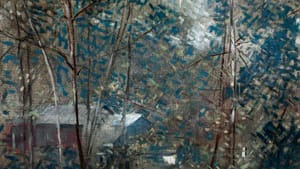Stay in the Loop
BSR publishes on a weekly schedule, with an email newsletter every Wednesday and Thursday morning. There’s no paywall, and subscribing is always free.
Pennsylvania town and country
The Michener Art Museum presents ‘Impressionism to Modernism’

The Michener Art Museum stands in the place of what was once a 19th-century prison modeled after Eastern State Penitentiary. It is now the legacy of James Michener, local author and philanthropist, and houses a permanent installation of Pennsylvania Impressionist works, as well as traveling exhibits from around the country. Now on view is the Lenfest Collection, a mix of American Impressionism and Modernism from the New Hope artist colony, displayed in its entirety for the first time.
The collection is a showcase of artists who made their homes in New Hope, PA between the late 1890s and the late 1950s, an idyllic country setting that still allowed them access to the major galleries and venues of Philadelphia and New York.
Different viewpoints
Michener’s current special exhibition is not a straightforward chronological progression, but an intermingling of pieces where a bucolic barn in a Bucks County winter is displayed next to a representational nude in bold strokes of blue and red. The disconnect is deliberate—the Pennsylvania Impressionists and the New Hope Modernists were contemporaries whose views of artistic expression often clashed, and the jarring effect of seeing two movements reconciled into a single collection highlights the differing viewpoints.
The Impressionists were clearly drawing from the more famous French masters who inspired their school of art, and the en plein air style they employed is filled with nostalgic charm. The soft, almost dreamy quality of the work feels like a determination to hold on to a place that hadn’t yet been consumed by industrialization. Despite being grounded in a very real place, the Impressionists are evoking an American fairy tale of sorts, the early 20th century not as it was, but as it could be, filled with dewy mornings and gentle snowfalls.

By contrast, the Modernists were leaning into change and progress. The abstracts that they produced wouldn’t be out of place in a gallery today, and it was clear that they had their fingers on the pulses of the big city arts scenes, eager to make their own colony a contender on the national stage. The subjects are far more universal than those favored Impressionist contemporaries, and the colors are richer and deeper.
Past and progressive
When local Modernists did portray New Hope, it was not in the sweeping blue skies of a countryside untouched by time, but rather the bustle of a waterfront town carving out its identity in a time of major economic and social change. It’s easy to read this as a statement of American social attitudes in 2019: a desire to be progressive mixed with a nostalgia for an idealized simpler time. I found the Modernist pieces the more striking, original, and memorable aspect of the collection, and mostly it’s because I do not believe in an idealized past. The soft focus blurs out the more glaring hardships that a rural life in the early 1900s entailed, and while progressivism can be challenging in its own right, the better world it cherishes is not an unattainable relic, but a very possible future.
The new BSR reader survey is live, and we want to hear from you! Complete this quick questionnaire, and we’ll enter you in a drawing for a gift certificate good for two Mural Arts Philadelphia tour tickets.
What, When, Where
Impressionism to Modernism: The Lenfest Collection of American Art. Through March 1, 2020 at the Michener Art Museum, 138 S Pine Street, Doylestown, PA. (215) 340-9800 or michenerartmuseum.org.
The Michener is fully wheelchair-accessible, and offers a range of services for patrons with disabilities, including ASL tours, assistive listening devices, and visual description tours. Visit online for details.
Sign up for our newsletter
All of the week's new articles, all in one place. Sign up for the free weekly BSR newsletters, and don't miss a conversation.
 Michelle Nugent
Michelle Nugent